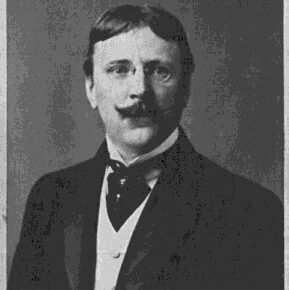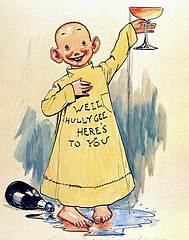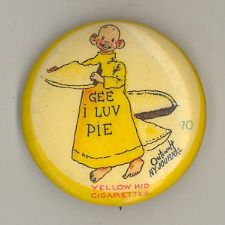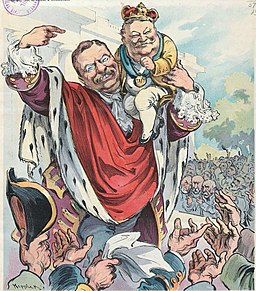The Year 1894
The time is 1894 and many things are happening around the country. The vaccine for diphtheria had been announced by Dr. Roux of Paris, The horrible Pullman Strike where workers were striking for the fact that their wages had been cut, but the rates the company charged them for rent had not. The strike will be short lived though, because the national guard will be called in to break it up. The Phillies will beat the Cincinnati Reds 21-8. There were also many famous people born, such as Norman Rockwell, artist for the Saturday Evening Post, Jack Benny, famous comedian and actor, and Harold L Gray the creator of Little Orphan Annie. Along with all these famous people coming into the world, a new kid will also arrive, and soon will be visiting everyone’s home. In my blog today I will introduce you to this kid, and the man who created him. I will give you a few interesting facts such as: where he came from, how he communicated, and why was he involved in a murder case. Read on and all will be answered!
It’s Sunday morning, and the paper has just arrived. Dad gets his sports page and Mom gets the lifestyle section, but I go for the comic strips. I loved Blondie, Beetle Bailey ,and Snuffy Smith. This seems to be a ritual that many of us had as children. Even today I enjoy a good comic strip.
The Start
When we think of comic strips, we mostly always think of the ones that ran in the Sunday newspaper. Interesting fact, the art form of combining words and pictures really started with the political newspapers of the 18th century. it satirized the political and social life of the day. That form of humor is still used today in newspapers, magazines and online. As shown in the picture below and no words used, the main point still comes across.
The cartoon we are going to learn about today is not a political cartoon, just the very first comic strip to make everyone sit up and take notice. His name is Yellow Boy. I will tell you who drew him and how his career evolved.
Richard F. Outcault: The Father of Yellow Boy
Richard F. Outcault was an American cartoonist that worked for John Pulitzer, and his newspaper The New York World. Outcault also found time to do drawings for a magazine called The Judge: a paper that was owned by a friend of Thomas Edison, a man that Outcault had also worked for earlier. He will in later times also work for William Randolph Hearst.


On June2, 1894 he created a large-eared, bald headed street kid in a gown. He continued working part time for The Judge, but on January 13, 1895 the character later to be known as the Yellow Boy came to life , and ran for the first time in The World newspaper. The kid’s backstory was he lived in the Irish ghetto in New York, wore a long gown that was a hand-me-down from his sister, [ it was not yellow yet because it was in black and white ] and had large protruding ears. In a May 5th edition in a cartoon titled “At the Circus in wasHogan’s Alley” the kid was first put out in color. Why was the shirt yellow? That was the color of the shirt his sister gave him, no other reason. The kid was from a large family known as the Dugans. It is also written that the Yellow Kid had the real name of Micky Dugan. I have not been able to verify this fact. The dialogue that was written for the strips soon started to appear on the Yellow Kid’s gown, just like in the picture above. It was theorized that from that happening it later turned into speech bubbles, just like we see today in comic strips. With the strip turning into the most popular comic strip of it’s time, it was distributed out to papers all over the country.
MARKETING
The next step for the kid was to be marketed. The Yellow kid made his appearance on items such as buttons, cigarette packs, cigars, cracker tins, ladies’ fans, matchbooks, postcards, toys, chewing gum, and billboards. Below is a button marketing the Yellow Kid and cigarettes. Mr. Outcault at this time tried to copyright the strip, and the Yellow Kids name for himself, but the courts ruled that characters themselves were too intangible to qualify for copyrights or trademarks. The court did rule in favor for the paper that it first ran in and they did get to own the name, and the title for copyright purpose.

With the success of the Yellow Kid, comic strip historian, Bill Blackbeard has stated ” That it makes it nothing less than the first definitive comic strip in history.” The Yellow Kid was just the start of many great comics to come, but as all good things it’s time came to an end, and on January 23, 1898 the last Yellow Kid strip ran.
INTERESTING FACTS
Now I would like to give you some interesting facts about the Yellow Kid and comic strips in general.
1. The first political cartoon was published in 1754 in the Pennsylvanian Gazette, a newspaper owned by Ben Franklin [ who also started the first hospital] it was a picture of a snake in pieces with the words “Join or Die” trying to band the first 13 colonies together.
2. What is the true story of the term “yellow journalism?” The two newspapers that ran the Yellow Kid: Pulitzer’s World, and Hearst’s Journal American, was known as the Yellow Kid papers. Because they were in competition with each other seeing who could get the most subscribers reading the Yellow Kid, this was termed the “Yellow Papers” and the term Yellow Kid newspapers was shortened to yellow journalism, describing the two newspapers’ editorial practices and [even fictionalizing] some sensationalism and making profit its top priority. Some of these practices are still in use today.
3. In a interview Outcault did in 1902 he stated “The Yellow Kid was not an individual but a type. When I use to go about the slums on newspaper assignments, I would encounter him[yellow kid] often, wandering out of doorways or sitting down on dirty doorsteps. I always lived the kid. He had a sweet character and a sunny disposition, and was generous to a fault. Malice, envy, or selfishness were not traits of his, and he never lost his temper.” He was talking about going into the slums around New York as he got a story and saw how all the kids acted.
4. The Yellow Kid’s head was drawn bald as if he had been shaven from having lice, a common site among children in the New York tenement slums at the time.
5. In 1929 in New York, the murder trial of Earl Peacox, a man who was accused and who confessed to the murder of his wife, was ongoing. There were witnesses to the murder and the defense council tried to get his client off using the insanity plea. It was well known at the time that the Peacox family had many relatives tucked away in institutions for this reason, one unparticular said he was the Yellow Kid and lived his life like the comic strip, and Mr. Peacox tried to get away using the same story. It wasn’t to be though. He was found guilty just the same and sent to prison.
6. Outcault also created another famous cartoon that still is around today or at least the title character is. The character Buster Brown was first drawn by him on May 4th 1902, and put un the Herald, a newspaper that was owned by Hearst. We still see this kid today when we buy Buster Brown shoes.
7. Mr. Outcault was the first artist to make colored comics and that is why we have them today.
8. In 1897 he published a book titled “The Yellow Kid in McFadden Flats.” It was 196 pages long and was in black and white. Finally there was also a dance at the time called the Yellow Kid, and it was performed on stage in New York, by actor Chuck Conners.
This ends the story of the Yellow Kid. If you happen read the daily funnies or still just on Sunday remember that without him who knows where we would be searching for a laugh.
Join me next week as we ride along delivering the way our postal system was set up in:
PLANES-TRAINS-AND POINIES


Wow, how interesting. The murder case adds another element!
I’m so sorry it took me so long to reply to your comment, I have been dealing with family issues. Thank you so much for reading my blog and commenting. Yes when I found that story in the old newspapers I knew I had to include it. I try to find at least one strange aspect to every post I write.
Wow this sounds so interesting! I’ve learned about yellow journalism and it intrigues me a lot.